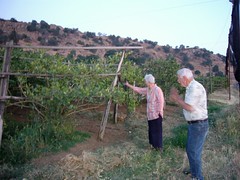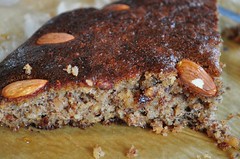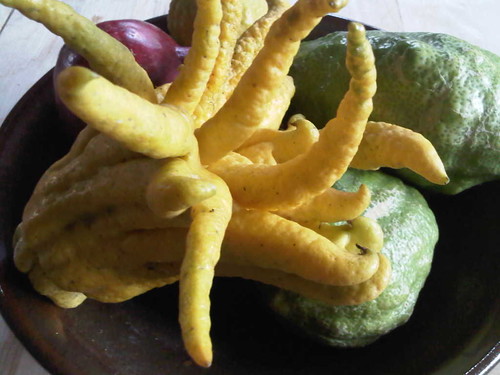In a “party hostess” panic, I threw the dehydrated citron peel in a jar and filled it with vodka then set out a Flourless Almond Citron Cake*, moving on to hunt for plates and forks. It was 30 minutes till our Slow Food group meeting for which John and Shirley Kirkpatrick were driving from the Central Valley to share the fruit (citrons and buddha’s hand) of their labor.
*Based on an Eating Well recipe, but with citron zest; doused with citron syrup; and half the honey, substituting half agave nectar.
 Panic averted: Our two-hour meeting extended to 4 hours filled with laughing, questions, tasting, sharing ideas, even good old fashioned joke telling. There was something different about this meeting, and today it hit me: Slow Food’s manifesto meets the Foodcrafters Manifesto (unveiled at this year’s Real Food Festival). Slow Food USA’s manifesto proclaims “that pleasure and quality in everyday life can be achieved by slowing down, respecting the convivial traditions of the table and celebrating the diversity of the earth’s bounty” and food that reflects “generations of commitment to the land and devotion to the processes that yield the greatest achievements in taste.”
Panic averted: Our two-hour meeting extended to 4 hours filled with laughing, questions, tasting, sharing ideas, even good old fashioned joke telling. There was something different about this meeting, and today it hit me: Slow Food’s manifesto meets the Foodcrafters Manifesto (unveiled at this year’s Real Food Festival). Slow Food USA’s manifesto proclaims “that pleasure and quality in everyday life can be achieved by slowing down, respecting the convivial traditions of the table and celebrating the diversity of the earth’s bounty” and food that reflects “generations of commitment to the land and devotion to the processes that yield the greatest achievements in taste.”
We went back to a slower time with this third-generation California citrus grower, who the Wall Street Journal once profiled on its front page (yes with one of those cool sketches!) and whose crop was once victim of espionage by a couple of Israeli rabbis.
It all started 30 years ago when John received a call from an 18 year old boy living back east, in search of etrogs (citrons). “Who should I speak with about having these grown in the U.S.?” he asked. “That’s me,” John answered, proceeding to dedicate himself to the task, learning the stringent religious laws; how to cultivate the fruit; and spoken Yiddish (I heard Alice Medrich admire this American Christian man’s pronunciation.)
Today he is the sole large grower in the United States. The farm also has lemons, olives, buddha’s hand (sold to St. George Spirits as well as kaffir lime leaves and mandarin blossoms), and assorted pomegranates.
Show, Tell & Eating Food Craft
 Rolling food craft into the meeting was a big part of our relaxed happiness. The Eat Real Festival’s Food Craft Manifesto states “Food craft is the transformation of raw ingredients into foods with techniques that change and build flavor, make foods last longer, and increase the impact of land and place on flavor.”
Rolling food craft into the meeting was a big part of our relaxed happiness. The Eat Real Festival’s Food Craft Manifesto states “Food craft is the transformation of raw ingredients into foods with techniques that change and build flavor, make foods last longer, and increase the impact of land and place on flavor.”
For the second time, this event format worked splendidly. John’s son dropped a case of fruit the week before. I distributed it to culinary takers.
June Taylor shared the fruits of her labor with John, presenting a small batch of citron preserves.
We started the meeting by tasting my citron vodka, which had largely had the peels in it for only an hour. A great discovery! This dehydration method immediately infuses the vodka with flavor that requires no sweetening.
We passed around chewy Citron Butter Mochi and candied citron peel. Then tried eating the citron’s mild white pith. (Later I dehydrated some slices which oddly have a kaffir lime leaf taste. Worth infusing in booze, eh?) Thoughts on extracting oil somehow led into tasting my first batch of homemade pickles.
Everyone left with bags of fruit, for continued experimentation.
While huge events reach more people, provide the opportunity to connect, and of course to sit at table togethers, I look forward to more of these smaller events to connect with the producers and sit at a splendid table, enjoying the pleasures that heritage foods and good people can only bring.


Need Raw Olives to Preserve or Craft?
John grows 30 acres of Manzanilla olives. If you’re interested in an event or want to buy olives to preserve and sell, he’s got ’em! I can connect you.






